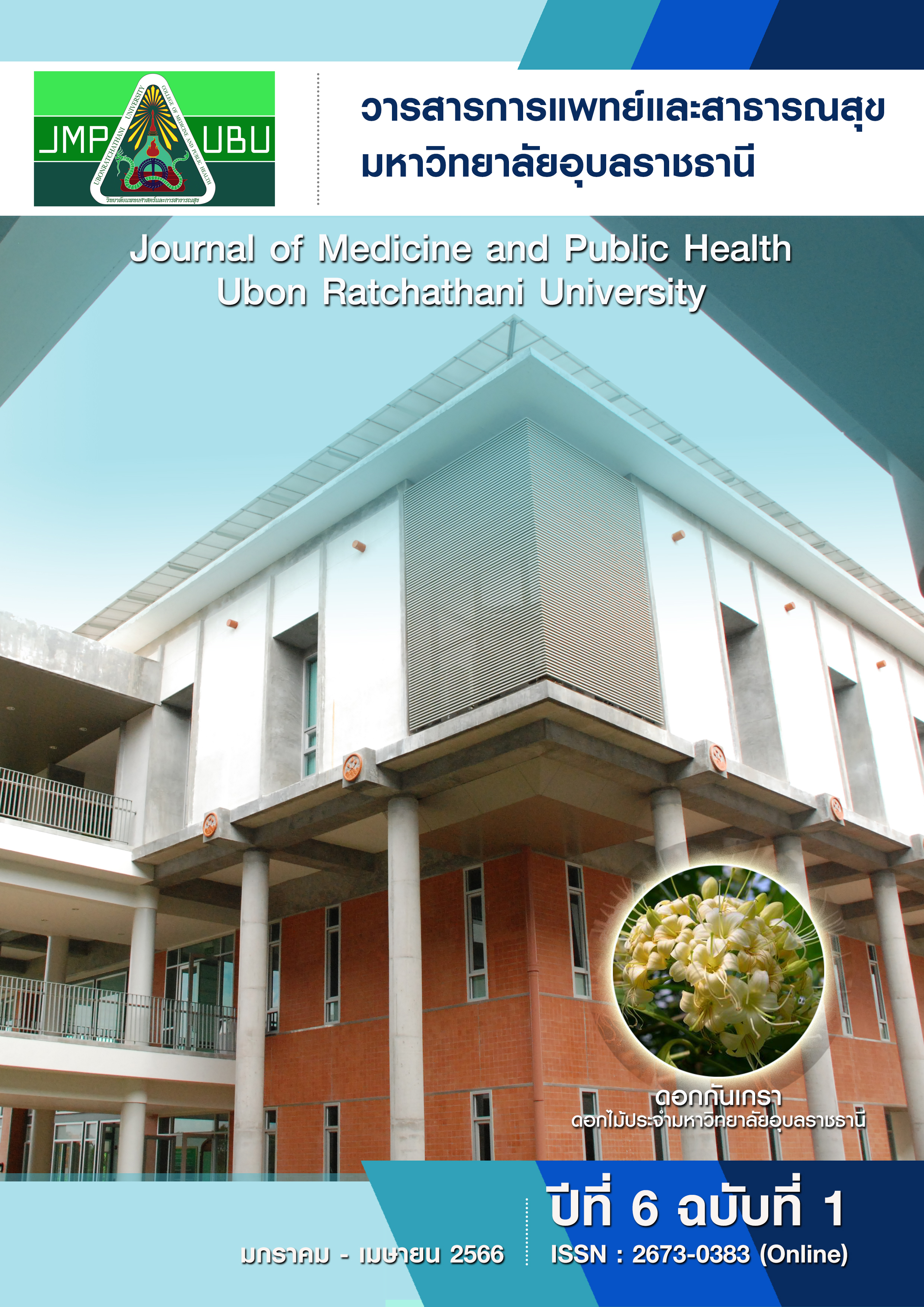การประเมินผลการมีส่วนร่วมของเจ้าพนักงานเภสัชกรรมในขั้นตอนการทวนสอบรายการยา ในหอผู้ป่วยใน: กรณีศึกษาโรงพยาบาลทั่วไปแห่งหนึ่ง ในจังหวัดอุบลราชธานี
คำสำคัญ:
การทวนสอบรายการยา, การประสานรายการยา, เจ้าพนักงานเภสัชกรรมบทคัดย่อ
การวิจัยนี้เป็นการวิจัยเชิงพรรณาแบบภาคตัดขวางเพื่อประเมินความถูกต้องและศึกษาระยะเวลาของการมีส่วนร่วมในขั้นตอนการทวนสอบรายการยาของเจ้าพนักงานเภสัชกรรมและเจ้าหน้าที่ห้องยา และศึกษาความพึงพอใจของเภสัชกรและความคิดเห็นของเจ้าพนักงานเภสัชกรรมและเจ้าหน้าที่ห้องยาต่อการทวนสอบรายการยา กลุ่มตัวอย่างคือ ผู้ป่วยใน
หออายุรกรรม เภสัชกร เจ้าพนักงานเภสัชกรรม และเจ้าหน้าที่ห้องยา จำนวน 513, 4, 12 และ 14 คน ตามลำดับ สุ่มตัวอย่างตามช่วงเวลาสำหรับกลุ่มผู้ป่วย และสุ่มแบบจำเพาะเจาะจงในกลุ่มเภสัชกร เจ้าพนักงานเภสัชกรรม และเจ้าหน้าที่ห้องยา
เก็บข้อมูลช่วงมีนาคม - กันยายน พ.ศ. 2564 เครื่องมือที่ใช้ คือ แบบบันทึกการทวนสอบรายการยา แบบสอบถาม
ความพึงพอใจ และแบบสอบถามความคิดเห็นต่อการทวนสอบรายการยา ผลการศึกษาพบว่า เจ้าพนักงานเภสัชกรรมและเจ้าหน้าที่ห้องยามีความถูกต้องของการทวนสอบรายการยาในภาพรวมคิดเป็นร้อยละ 92.51 และ 90.02 ส่วนใหญ่มีความถูกต้องในระดับมากกว่าร้อยละ 90.00 ขึ้นไปทั้งสองกลุ่ม เวลาในการทวนสอบยา 1 รายการเท่ากับ 0.82 และ 0.94 นาที ตามลำดับ เมื่อทดสอบความสัมพันธ์ของจำนวนรายการยากับความถูกต้องของการทวนสอบด้วย Pearson correlation พบว่า ในกลุ่มเจ้าหน้าที่ห้องยาจำนวนรายการยามีความสัมพันธ์เชิงลบกับความถูกต้องของการทวนสอบขนาดยาในระดับ
น้อยมาก (r = -.256, p-value < .001) เภสัชกรพึงพอใจต่อการทวนสอบของเจ้าพนักงานเภสัชกรรมในระดับมาก
( = 4.07, SD = 0.66) ชี้ให้เห็นว่าเจ้าพนักงานเภสัชกรรมสามารถทวนสอบรายการยาได้อย่างมีประสิทธิภาพและมีประโยชน์ต่อขั้นตอนนี้
Downloads
เอกสารอ้างอิง
จันทร์จารึก รัตนเดชสกุล และภาสกร รัตนเดชสกุล. ความคลาดเคลื่อนทางยา (Medication error) กับการใช้ประโยชน์ในระบบจัดการด้านยา [อินเทอร์เน็ต]. [สืบค้นเมื่อ 21 มกราคม 2564]. แหล่งข้อมูล: https://ccpe.pharmacycouncil.org/index.php?option=article_detail&subpage=article_detail&id=303
Irwin AN, Young Yoon H and Gerrity TM. Expanded Roles for Pharmacy Technicians in the Medication Reconciliation Process: A Qualitative Review. Hosp Pharm 2017;52(1):44-53.
Pevnick JM, Nguyen C, Kackevicius CA, Palmer KA, Shane R, Cook-Wiens G et al. Improving Admission Medication Reconciliation with Pharmacists or Pharmacy Technicians in the Emergency Department: A Randomized Controlled Trial. BMJ Qual Saf 2018;27(7):512–20.
Nguyen JT, Ziser KE, Penm J and Schneider CR. Impact of a pharmacy technician on clinical pharmacy services in an Australian hospital. Int J Clin Pharm 2019;41(2):445-51.
Kraus SK, Sen S, Murphy M and Pontiggia L. Impact of a pharmacy technician-centered medication reconciliation program on medication discrepancies and implementation of recommendations. Pharm Pract 2017;15(2):1-4.
Nguyen CB, Shane R, Bell DS, Cook-Wiens G and Pevnick JM. A Time and Motion Study of Pharmacists and Pharmacy Technicians Obtaining Admission Medication Histories. J Hosp Med 2017;12(3):180–3.
Patel S, Mathis AS, Costello J, Ghin HL, and Fahim G. Satisfaction With Medication Reconciliation Completed by Pharmacy Technicians in an Emergency Department. P&T 2018;43(7):423-8.
Johnston R, Saulnier L and Gould O. Best Possible Medication History in the Emergency Department: Comparing Pharmacy Technicians and Pharmacists. Can J Hosp Pharm 2010;63(5): 259-65.
Chan C, Woo R, Seto W, Pong S, Gilhooly T and Russell J. Medication Reconciliation in Pediatric Cardiology Performed by a Pharmacy Technician: A Prospective Cohort Comparison Study. Can J Hosp Pharm 2015;68(1):8-15.
Niederhauser A, Zimmermann C, Fishman L and Schwappach DL. Implications of involving pharmacy technicians in obtaining a best possible medication history from the perspectives of pharmaceutical, medical and nursing staff: a qualitative study. BMJ Open 2018;8(5):1-10.
กลุ่มประสานนโยบายและยุทธศาสตร์กำลังคนด้านสุขภาพ กองบริหารทรัพยากรบุคคล สำนักงานปลัดกระทรวงสาธารณสุข. แผนปฏิรูปกำลังคนและภารกิจบริการด้านสุขภาพของกระทรวงสาธารณสุข. นนทบุรี: สื่อตะวัน; 2562.
ศิริรัตน์ ไสไทย และโพยม วงศ์ภูวรักษ์. ผลของกระบวนการสร้างความสอดคล้องต่อเนื่องทางยาในหอผู้ป่วยอายุรกรรมหญิง โรงพยาบาลทั่วไปแห่งหนึ่ง. วารสารเภสัชกรรมไทย 2556;5(1):86-92.
อรุณ จิรวัฒน์กุล. เกณฑ์คัดเข้าและคัดออกคืออะไร. วารสารวิชาการสาธารณสุข 2560;26(1):974–75.
อรุณ จิรวัฒน์กุล. การเลือกตัวอย่างผู้ป่วยที่เข้ารับการรักษาในโรงพยาบาล ณ ช่วงเวลาที่กำหนดเป็นการเลือกตัวอย่างแบบใด. วารสารวิชาการสาธารณสุข 2547;13(1):713–14.
Hinkle DE, Wiersma W, Jurs SG. Applied Statistics for the Behavioral Sciences 5th ed. Boston: Houghton Mifflin. 2003.
ดาวน์โหลด
เผยแพร่แล้ว
รูปแบบการอ้างอิง
ฉบับ
ประเภทบทความ
สัญญาอนุญาต
ลิขสิทธิ์ (c) 2022 วารสารการแพทย์และสาธารณสุข มหาวิทยาลัยอุบลราชธานี

อนุญาตภายใต้เงื่อนไข Creative Commons Attribution-NonCommercial-NoDerivatives 4.0 International License.
เนื้อหาและข้อมูลในบทความที่ลงตีพิมพ์ในวารสารการแพทย์และสาธารณสุข มหาวิทยาลัยอุบลราชธานี ถือเป็นข้อคิดเห็นและความรับผิดชอบของผู้เขียนบทความโดยตรง ซึ่งกองบรรณาธิการวารสารไม่จำเป็นต้องเห็นด้วย หรือร่วมรับผิดชอบใด ๆ
บทความ ข้อมูล เนื้อหา รูปภาพ ฯลฯ ที่ได้รับการตีพิมพ์ในวารสารการแพทย์และสาธารณสุข มหาวิทยาลัยอุบลราชธานี ถือเป็นลิขสิทธิ์ของวารสารการแพทย์และสาธารณสุข มหาวิทยาลัยอุบลราชธานี กองบรรณาธิการไม่สงวนสิทธิ์ในการคัดลอกเพื่อการพัฒนางานด้านวิชาการ แต่ต้องได้รับการอ้างอิงที่ถูกต้องเหมาะสม






